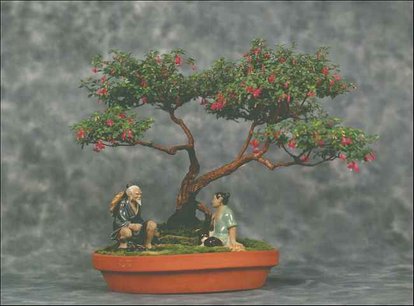Is repotting old fuchsias so necessary?
Once a member of our fuchsia association, known for the great large and richly flowering plants he presented at exhibitions, told me that fuchsias grow well even on street rubbish.
That this is possible he attributed to the many sand that is in it, and that the sand ensures that this keeps the 'substrate' airy. His plants stood in the same soil for years and he proved that repotting old fuchsias is not absolutely necessary.
I myself also have the experience that potting soil is not really necessary for growing a good plant.
9 cm. pots foto S. van Schaik
The oldest plant of my Fuchsia bonsai is 16 years old and has been standing for 12 years in a scale with a diameter of 30 cm and a ground height of 4 cm.
The plant height is 70 cm while the crown diameter measures 50 cm.
In those 10 years, this bonsai has not been out of the scale, while it still grows every year and flourishes. However, this kind of plants, which have relatively little soil, are not placed in full sun but in a bright spot from the sun.
This is how I cultivated plants for the 'Drs. Mia van der Zee Kruseman 'trophy for the national competition of the NKvF region Zuid-Gelre.
For this one has to grow plants in a pot of around 9 cm and a height of 9 cm (I did not use sand).
These plants remained in that pot for four or five years and then reached a height of 35 cm with a crown of 30 cm, while the thickness of the stem was 1 cm. They have not been repotted for years.
I once disassembled the root ball of one of those plants and then it appeared that 3/4 part consists of roots.
foto: Hans van Aspert
Both examples indicate that repotting in new potting soil is unnecessary. Only to make it easier, the pot is adapted to the size of the plant.
Another advantage with our cultivated fuchsias is that they overwinter rather cold, with all hair roots dying off and in the spring they serve as food for the plants. In the hair roots there are fertilizers, which are then taken up as food. This also has disadvantages, of course, and you will find that especially in varieties that have little or no thick roots.
The greenhouse horticulture also shows that potting soil is superfluous. Here, for example, tomatoes and cucumbers are grown on stone wool, which is light but in which there is no food. The art is here in the way of watering and fertilizing.
Old soil, which has been in the pot for years, keeps less water because many roots have taken its place. That can be overcome by giving more regular water. If the soil still holds bad water, put a few drops of detergent in the irrigation water.
Dried cow manure grains
Photo: S. van Schaik
Opinions differ about the fertilization of the plants. My way of fertilizing is the next.
In the spring I make vulture from old manure or dried cow manure grains. I add this to the irrigation water, which I give to the plants every other week from the end of March to the end of July.
The ratio used is: a hand full of grains or old manure on five liters of water. This mixture is given to the plants, but they must already have a moist root ball.
When the plants go outside I put holes in the ground at about 8 cm from the trunk, and do Osmocote grains. (15-10-15 + trace elements)
Make sure there is at least 5 to 8 cm of space between the grains and the pot edge. Because these granules work on heat, you prevent over-fertilization. Furthermore, my plants no longer get manure, not even to harden. Only all my plants that are in pots are given chili nitrate one week before pruning.
This quickly absorbable nitrogen promotes the start of new growth points.
It is also possible to fertilize plants with fertilizers added to the irrigation water, eg 20-20-20, use a ½ gram per liter, every other day, make sure the pot soil is moist.
Also make sure that you do not use too large pots, plants may be better to dry than a few days too wet.
My plants are always in terracotta pots that are just a bit bigger than the plastic pots where they are wintered.
When they pot again for the winter, they go back into the same plastic pot they were in.
'Jaspers Hardy King' Photo: Hans van Aspert
Plants that are in the ground with me are not fertilized, they get a little cow dung, depending on the size, when planting.
These plants are never further fertilized by me and always bloom well.
The soil of my garden is sand, where I mix potting soil from my flower boxes and pots.
Planting in the open ground works well in soil types that consist of sand, peat, woodland and sand clay.
I would not plant my plants in the clay soil.
The plants also go into the greenhouse as late as possible, while I make sure that the pot roots are dry.
Author: Hans van Aspert
layout: S. van Schaik
